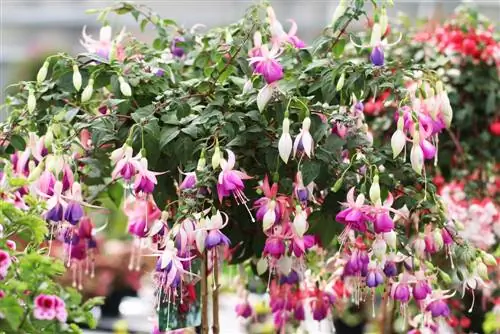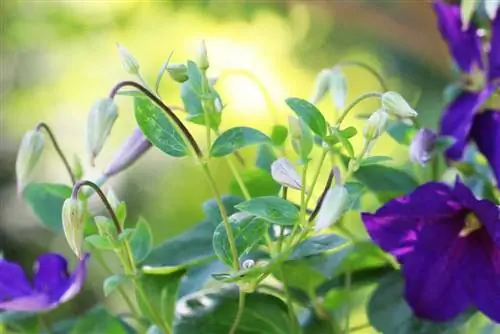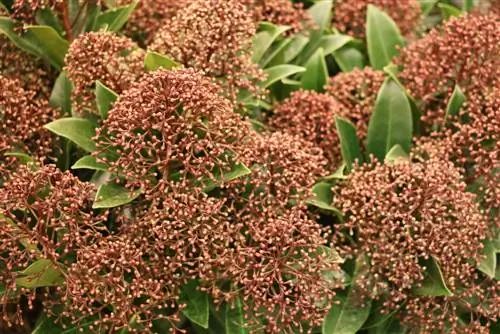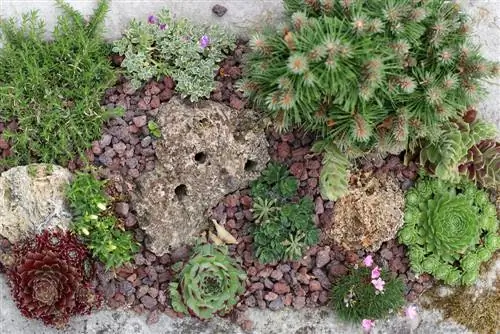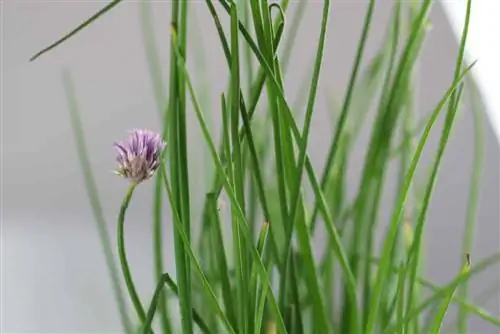- Author admin [email protected].
- Public 2023-12-17 03:39.
- Last modified 2025-06-01 06:48.
Climbing and climbing plants provide a contemplative and cozy ambience and sufficient privacy in summer. Another advantage of such plants is the sun and wind protection they provide. Climbing plants are suitable for any size garden or house wall. Thanks to their hardiness, they exude a special garden romance all year round. If you want to enjoy the beauty of evergreen climbing plants all year round, you should carefully consider the site conditions. Because only if a plant feels comfortable all around can it thrive.
Ivy
The evergreen classic plant can cover an entire wall with its fantastic greenery. With the help of the adhesive roots, the ivy provides the necessary hold, but also leaves the so-called fingerprints on the house wall if the masonry needs to be freed from ivy
- West or north facing wall as a location
- acidic soil should be avoided, otherwise the ivy is very adaptable
- no soil compaction at all
- Soil should always be a little moist
- needs to be watered regularly even in winter
- easy pruning
- Trellis required from around ten meters, but advantageous
- particularly frost-resistant
- fast growth, approx. 2 meters per year
- can grow to a height of 25 meters, depending on the variety
Climbing spindle bush or creeping spindle
An evergreen climbing plant with adherent roots that are flat.
- full sun location, but also partial shade or full shade; The plant is also suitable for more shaded areas, such as a north-facing wall
- It is very adaptable, but requires sufficient moisture
- no soil compaction, a sandy, humus-rich soil has a favorable effect
- Avoid the plant being dry for a long time, especially when it is hot, otherwise the lack of water will result in leaf drop in autumn
- It tolerates pruning and can be cut back two to three times a year
- A trellis is not absolutely necessary, as the plant has adhesive roots and only grows at a low height
- The shoots can be attached with commercially available kneading wax, but you should be careful as the shoots can also grow into joints
Honeysuckle

Another evergreen climbing plant and a creeper. It is an excellent alternative to ivy. Lack of water can be recognized by curled leaves. This serves as self-protection and against excessive evaporation through the leaves.
- sunny location with partial shade
- fresh, moist and nutrient-rich soil
- Flowering from June to August with yellow-red flowers, followed by small, round blue-black berries
- can be cut back easily in spring
- Use net-shaped aids or vertical compartments as climbing aids; Branches and cross elements are important because the honeysuckle is a creeper with medium growth
- annual growth of 30 - 60 cm
- Growth height of 8 m
Passionflower
The hardy, climbing passion flower is also perfect for beautifying fences, climbing wire or obelisks. Their exotic flowers spread a certain flair throughout the entire summer. It does not form any adhesive feet and therefore leaves the masonry undamaged. However, it needs a climbing aid with which it can climb in a spiral. Although it has a tropical origin, it is still easy to care for and undemanding. As a potted plant or in a garden bed, it is a special eye-catcher and a feast for the eyes.
- sunny to partially shaded location
- Distance from other plants at least 50 to 60 centimeters
- medium to high water requirement
- low maintenance
- Growth height up to 150 centimeters
Wild Wine
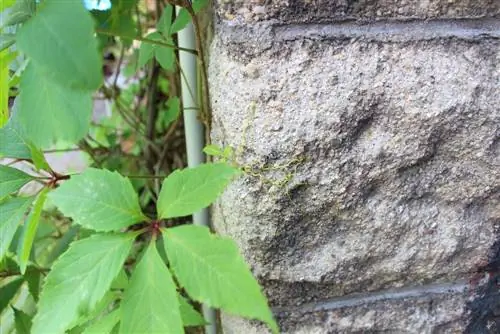
It is a hardy climber and clinging rooter and particularly scores points with its bright and pretty autumn color, when its leaves turn into a bright red.
- sunny to partially shaded location
- strong growth with a height of between ten and twelve meters
- normal garden soil is sufficient
- robust and easy to care for
- wind-friendly
- Climbing assistance is helpful, but not necessary
Winter Jasmine
A spreading climber and an evergreen climbing plant that grows free-standing into loose and low, but still strongly overhanging shrubs. As a herald of early spring, it looks particularly beautiful on walls. It is good to keep in pots on balconies and terraces.
- protected partially shaded to sunny location
- permeable and nutrient-rich soil
- Pruning every two to three years, which should take place in the spring after flowering
- When using a climbing frame up to 2 meters high
- 2 to 3 cm large flowers that can bloom as early as December.
Climbing hydrangea
It is also a sticky rooter, but still needs climbing aid in the first year. She then climbs up walls, trees and pergolas completely independently. It impresses with beautiful, shiny, dark green leaves. It also grows very luxuriantly.
- It feels comfortable in sunny or partially shaded locations
- Flowering period from June - July with a white, flat, fragrant and umbrella-like flower
- Their height is between 3.5 and 5 meters
- normal garden soil is completely sufficient
Wisteria
It is also known as wisteria and is a very popular plant in local gardens. The wisteria is a beautifully flowering climbing plant, is considered a creeper and grows quickly and strongly. It is suitable for vegetation on facades, house corners, pergolas and arbors.
- sunny location
- Flowering period from May to June
- Growth height approx. 10 m
- Climbing assistance is needed
- quite undemanding when it comes to the nature of the soil; Nevertheless, sandy-loamy soils are very suitable
- adequate water supply is required
Hops
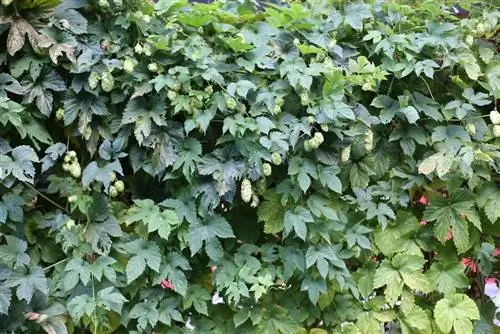
The hop is a creeper and a fast-growing climbing plant. This means that if you want your objects such as pergolas or house walls to be covered quickly, choose hops.
- a sunny to partially shaded location benefits growth
- the flowering period with light yellow flowers is from June to September
- strong growth up to 10 meters high
- the soil should be nutrient-rich and moist
Climbing roses
The Queen of Flowers is also available as a climbing variety. Depending on the genus, roses are available that bloom once a year and others that bloom more frequently. Arches, fences or trellises can be decorated with climbing roses. Pergolas or arbors can also be covered with them. With a growth height of 1.5 to 5 meters, it is also well suited for smaller wall surfaces.
- Southeast or southwest walls are suitable as a location
- loamy soil rich in humus, but without waterlogging
- the soil is always supplied with sufficient water and nutrients
- In winter the plants need winter protection at the base, this can be done with brushwood or spruce branches
- cutting is done every one to two years, either in late winter or before the start of spring, always after the strongest frost
Trumpet flower, trumpet morning glory
She is a root climber and a true climbing artist. It impresses with its beautiful orange flowers, which are trumpet-shaped, which also gives rise to its name. It also has lush green leaves. A climbing aid is only necessary on very smooth walls.
- full sun to sunny location
- Flowering period from June to September
- all normal garden soils are sufficient for her to thrive
- pruning may only be done in spring.
- It easily reaches a height of eight meters
Clematis
The Clematis is a petiole vine and a beauty in itself. They come in different types and colors. Planting on the terrace in pots or other containers as well as on the balcony can be excellently created with clematis.
- a sunny to partially shaded location
- the flowering period is from May to September
- Humos soil
- Shading the base - the lower 20 to 25 cm - of the clematis is beneficial; this can be achieved with ground cover or decorative perennials
- Pruning should be done between November and December in the first year
Afterwards, different pruning regulations apply depending on the type of clematis plant
What you need to know about climbing plants
Climbing plants are particularly ideal for small gardens. There they can grow in height instead of in width. This means you can accommodate many different plants even in small areas.
Perennial climbing plants are also well suited for greening house facades.
Facade greening enhances buildings aesthetically and ensures a balanced living environment. They also protect the masonry from the effects of the weather. However, you have to be careful with self-climbers who use adhesive organs to climb directly up the wall. To avoid unpleasant surprises, you should always provide a support structure for the plants. There are extensive kits and climbing aids for all purposes.
Perennial climbing plants generally do not need much care. They need sufficient water and regular fertilizer during the main growing season. However, you have to prune them regularly. A flower only appears when the buds are stimulated to bloom by pruning. Strongly growing, sprawling shoots should be cut back to cones, i.e. above a strong bud. The many two to three year old thin shoots can be removed. Larger, sprawling branches should be rejuvenated with a saw if necessary.


